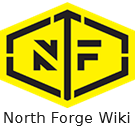More actions
John Hache (talk | contribs) m Add E-STOP diagram |
John Hache (talk | contribs) Tips for avoiding spoilboard damage Tags: Mobile edit Mobile web edit |
||
| Line 132: | Line 132: | ||
If your cut penetrates deeper than 0.06” into the spoilboard, please stop and investigate. If the stock is set up correctly and the depth of cut is appropriate, the collet may be dirty or damaged and the tool slipping out, or the secondary spoilboard may not be perfectly parallel to the gantry (for example due to debris between the primary and secondary spoilboard). | If your cut penetrates deeper than 0.06” into the spoilboard, please stop and investigate. If the stock is set up correctly and the depth of cut is appropriate, the collet may be dirty or damaged and the tool slipping out, or the secondary spoilboard may not be perfectly parallel to the gantry (for example due to debris between the primary and secondary spoilboard). | ||
Tips: | |||
* Zero to the spoilboard, not the top of the stock | |||
* Use conservative cut depths and nudge down as needed (for example, by using Z nudge function or manually tweaking z zero) | |||
* Test toolpaths on a secondary spoilboard | |||
* Measure stock with calipers | |||
==== '''SCREWS''' ==== | ==== '''SCREWS''' ==== | ||
When using North Forge’s ''secondary'' spoilboard, it is okay to screw the workpiece in place. Do not screw into the main vacuum spoilboard. Do not use excessively long screws (ie long enough to pierce both the secondary spoilboard and the vacuum spoilboard). | When using North Forge’s ''secondary'' spoilboard, it is okay to screw the workpiece in place. Do not screw into the main vacuum spoilboard. Do not use excessively long screws (ie long enough to pierce both the secondary spoilboard and the vacuum spoilboard). | ||
